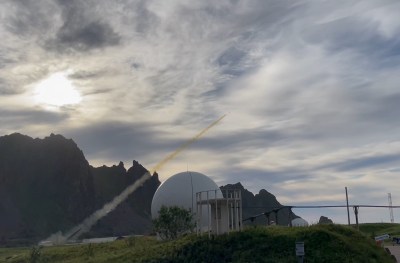The US has just successfully tested a Tactical High-speed Offensive Ramjet for Extended Range (THOR-ER) hypersonic vehicle, providing a significant boost to its weapons program that until now has been perceived as lagging behind China and Russia’s.
In a press release this month, the US Department of Defense (DOD) said that the US and Norway successfully tested the THOR-ER, with the vehicle firing several times, on August 17. The test showed the viability of solid-fuel ramjet propulsion (SFRJ) technology and demonstrated a significant increase in range, it said.
Aviation website SKYbrary notes that a ramjet, an air-breathing engine with no moving parts such as a rotary compressor that uses forward motion to compress incoming air, is the simplest method of achieving supersonic flight.
Because they have no moving parts, ramjets cannot be used at zero airspeeds. Instead, they can be started at 185 kilometers per hour but do not produce significant thrust until Mach 0.3 and reach peak efficiency at Mach 3.
Ramjets are also limited to a maximum speed of Mach 6 due to shockwave-induced pressure loss that occurs when slowing the intake air to subsonic speed.
The DOD claims that the first flight test, reportedly conducted on August 17 at Andoya in Norway, demonstrated unguided SFRJ operation across a wide range of speeds and altitudes.
The second test, conducted the following day, reportedly focused on a high thrust flight profile. Both test flights successfully demonstrated high flight speeds before ramjet burnout and splashdown.
“The SFRJ flight vehicle was accelerated to above Mach 2 with the help of a solid rocket booster and transitioned to ramjet mode. The flight phase was a resounding success with stable flight, robust ramjet operation, and a high thrust-to-drag ratio,” claimed Stein Erik Nodeland, executive vice president of Aerospace Propulsion at the Nordic Ammunition Company (NAMMO).
The DOD statement says that the tests achieved the THOR-ER Phase 1 objective of demonstrating jointly-developed technologies in flight, such as new high-energy fuels, advanced air injection and throttling methodologies critical for future mission-flexible SFRJ systems.
This success is a quick follow-up to the third test of its Hypersonic Air-breathing Weapon Concept (HAWC) this July, which also used a scramjet engine.

DARPA noted that after release from the test aircraft, HAWC’s first-stage boosters pushed it to the expected scramjet ignition envelope. From there, its scramjet engine fired and propelled it to Mach 5 for more than 555 kilometers at an altitude of 18,288 meters.
HAWC’s second flight test in September 2021 demonstrated the capabilities to make hypersonic cruise missiles an effective tool for US warfighters, noted Andrew Knoedler, HAWC program manager in DARPA’s Tactical Technology Office.
As with the first test, an aircraft released the missile seconds before its scramjet engine kicked on, compressing incoming air with its hydrocarbon fuel and propelling it to Mach 5.
DARPA noted that all test mission primary objectives were accomplished, such as safe separation from the launch aircraft, booster ignition and boost, booster separation and engine ignition and cruise.
While hypersonic weapons are barely past the prototype stage, the technology behind them, such as scramjet engines, are rapidly maturing, gradually lowering costs.
In addition, scramjets are much less reliant on exotic materials than other hypersonic systems, which significantly reduces costs as traditional metals are more accessible to source and can be purchased in large quantities, notes Wes Kremer, president of the missiles and defense unit at Raytheon.
This simplification of hypersonic weapon design may eliminate one cause of failure that has so far dogged US hypersonic weapons development.
Asia Times has noted that the overly complex design of US hypersonic weapons may have caused previous failures, with the two-stage design used by some US prototypes requiring complex integration of subsystems and multiple tests.
Using SFRJ technology such as THOR-ER eliminates difficulties in liquid-fuel systems, negating the need for difficult and dangerous-to-store fuels, pre-flight fueling and complicated pumps within hypersonic missiles.
However, SFRJ technology presents its own technological challenges. In solid-fuel systems, once combustion has started, it cannot be stopped and can only be controlled with great difficulty.
Moreover, the use of scramjets will reduce supply chain vulnerabilities in America’s hypersonic weapons program, eliminating the possibility that China exploits its near-monopoly on rare-earth metals to hobble it.
Asia Times has reported on this vulnerability, noting that the discovery of Made in China magnets in the US premier F-35 fighter this August forced the US to temporarily stop jet deliveries, with significant implications for its airpower capabilities and those of its allies.

The US may now look at hypersonic weapons designs that do not rely on China’s rare-earth metals. This March, Breaking Defense reported on Australia’s 3D printed scramjet engine, which reduces reliance on rare-earth metals and has been presented to US officials.
The report notes that Australia’s engine is made of Inconel, a tough and heat-resistant alloy. The specific alloy may be Inconel-617, a nickel-chromium-cobalt-molybdenum-aluminum blend designed for increased strength and stability at high temperatures, and is widely used in gas turbine hot gas paths, combustion cans, ducting, and liners. None of Inconel-617’s ingredients are rare-earth metals, on which China has a potential supply chokehold.
Although China, Russia, and the US are locked in a hypersonic weapons race, the US does not seem to have a clear doctrine or strategy for its hypersonic weapons, as opposed to China and Russia, which plan to incorporate such weapons into their strategic nuclear arsenals.
Despite that, Dan Gouré, in a 2021 article for Real Clear Defense, notes that the US sees its investments in hypersonic weapons as a means to compensate for the loss of its deep strike capabilities due to the proliferation of China and Russia’s anti-access/area denial (A2/AD) capabilities, meaning they will likely be deployed for conventional rather than nuclear purposes.

